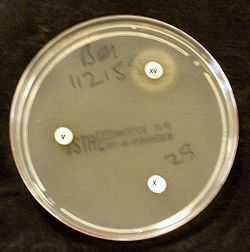Bacterial inhibition assay

A bacterial inhibition assay is an assay that uses bacterial colony growth as a semi quantitative indicator to measure the concentration of a product in an sample.
Example: classical Guthrie test
The Guthrie bacterial inhibition assay was a semiquantitative assay designed to detect elevated blood levels of the amino acid phenylalanine, using the ability of phenylalanine to facilitate bacterial growth in a culture medium with an inhibitor.
A drop of blood is usually obtained by pricking the heel of a newborn infant and is collected on a piece of filter paper. A small disk of the filter paper is punched out and placed on an agar gel plate containing Bacillus subtilis and B-2-thienylalanine. Each gel holds 60-80 disks. The agar gel is able to support bacterial growth but the B-2-thienylalanine inhibits bacterial growth. However, in the presence of extra phenylalanine leached from the impregnated filter paper disk, the inhibition is overcome and the bacteria grow. Within a day the bacterial growth surrounding the paper disk is visible. The amount of growth, measured as the diameter of the colony, is roughly proportional to the amount of phenylalanine in the serum. The result is read by comparing the diameter of each sample disk's colony to the colonies of a series of reference disks with standard phenylalanine content included on each large plate.
The Guthrie bacterial inhibition assay is sensitive enough to detect serum phenylalanine levels of 180-240 μmol/L (3–4 mg/dL). In healthy normal people, phenylalanine levels are usually under 120 μmol/L.
The test has been widely used throughout North America and Europe as one of the core newborn screening tests since the late 1960s. The classical Guthrie bacterial inhibition assay is gradually being replaced in many areas by newer techniques such as tandem mass spectrometry that can detect a wider variety of congenital diseases.